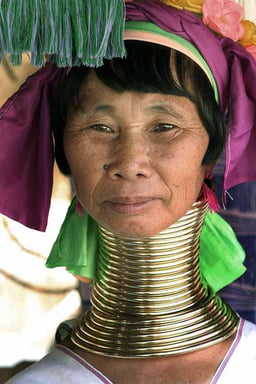Femininity
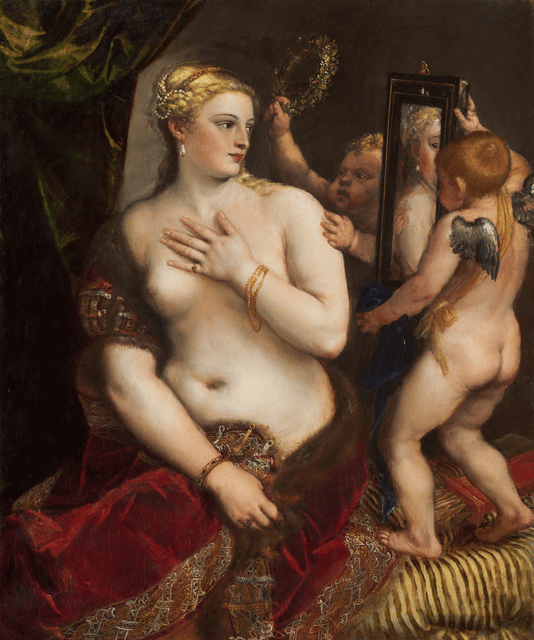
Femininity
Femininity (also called girlishness or womanliness) is a set of attributes, behaviors, and roles generally associated with girls and women. Femininity is made up of both socially-defined and biologically-created factors.[1][2][3] This makes it distinct from the definition of the biological female sex,[4][5] as both males and females can exhibit feminine traits.
History
Tara Williams has suggested that modern notions of femininity in English speaking society began during the English medieval period at the time of the bubonic plague in the 1300s.[12] Women in the Early Middle Ages were referred to simply within their traditional roles of maiden, wife, or widow.[12] After the Black Death in England wiped out approximately half the population, traditional gender roles of wife and mother changed, and opportunities opened up for women in society. Prudence Allen has traced how the concept of "woman" changed during this period.[13] The words femininity and womanhood are first recorded in Chaucer around 1380.[14][14]
In 1949, French intellectual Simone de Beauvoir wrote that "no biological, psychological or economic fate determines the figure that the human female presents in society" and "one is not born, but rather becomes, a woman,"[16] an idea that was picked up in 1959 by Canadian-American sociologist Erving Goffman[17] and in 1990 by American philosopher Judith Butler,[18] who theorized that gender is not fixed or inherent but is rather a socially defined set of practices and traits that have, over time, grown to become labelled as feminine or masculine.[19] Goffman argued that women are socialized to present themselves as "precious, ornamental and fragile, uninstructed in and ill-suited for anything requiring muscular exertion" and to project "shyness, reserve and a display of frailty, fear and incompetence."[20]
Second-wave feminists, influenced by de Beauvoir, believed that although biological differences between females and males were innate, the concepts of femininity and masculinity had been culturally constructed, with traits such as passivity and tenderness assigned to women and aggression and intelligence assigned to men.[21][22] Girls, second-wave feminists said, were then socialized with toys, games, television and school into conforming to feminine values and behaviours.[21] In her significant 1963 book The Feminine Mystique, American feminist Betty Friedan wrote that the key to women's subjugation lay in the social construction of femininity as childlike, passive and dependent,[23]*Gender%2FBody%2FKnowledge%3A%20]]*Gender%2FBody%2FKnowledge%3A%20]]*Gender%2FBody%2FKnowledge%3A%20]]*Gender%2FBody%2FKnowledge%3A%20]]*Gender%2FBody%2FKnowledge%3A%20]]*nd called for a "drastic reshaping of the cultural image of femininity."
Behavior and personality

Young Woman Drawing (1801, Metropolitan Museum of Art) painted by Marie-Denise Villers (possibly a self-portrait), depicts an independent feminine spirit.[27]
While the defining characteristics of femininity are not universally identical, some patterns exist: gentleness, empathy, sensitivity, caring, sweetness, compassion, tolerance, nurturance, deference, and succorance are traits that have traditionally been cited as feminine.[6]%22Femininity%2C%22%20%22masculin]] [8][25][26]
Femininity is sometimes linked with sexual objectification and sexual appeal.[28]*Female%20ste]]*Female%20ste]]*Female%20ste]]*Female%20ste]]Female%20ste]]
People who exhibit a combination of both masculine and feminine characteristics are considered androgynous, and feminist philosophers have argued that gender ambiguity may blur gender classification.[30][31] Modern conceptualizations of femininity also rely not just upon social constructions, but upon the individualized choices made by women.[32]
Ann Oakley's sex/gender dichotomy has had a considerable influence on sociologists defining masculine and feminine behavior as regulated, policed, and reproduced in our society, as well as the power structures relating to the concepts.
An ongoing debate with regards to sex and psychology concerns the extent to which gender identity and gender-specific behavior is due to socialization versus inborn factors.[1][33] According to Diane F. Halpern, both factors play a role, but the relative importance of each must still be investigated.[34] The nature versus nurture question, for example, is extensively debated and is continually revitalized by new research findings.[33] Some hold that feminine identity is partly a 'given' and partly a goal to be sought.[35]
In 1959, researchers such as John Money and Anke Erhardt proposed the prenatal hormone theory. Their research argues that sexual organs bathe the embryo with hormones in the womb, resulting in the birth of an individual with a distinctively male or female brain; this was suggested by some to "predict future behavioral development in a masculine or feminine direction".[1] This theory, however, has been criticized on theoretical and empirical grounds and remains controversial.[36][37] In 2005, scientific research investigating sex and psychology showed that gender expectations and stereotype threat affect behavior, and a person's gender identity can develop as early as three years of age.[38] Money also argued that gender identity is formed during a child's first three years.[33]
Mary Vetterling-Braggin argues that all characteristics associated with femininity arose from early human sexual encounters which were mainly male-forced and female-unwilling, because of male and female anatomical differences.[6] Others, such as Carole Pateman, Ria Kloppenborg, and Wouter J. Hanegraaff, argue that the definition of femininity is the result of how females must behave in order to maintain a patriarchal social system.[28]*Female%20ste]]*Female%20ste]]*Female%20ste]]*Female%20ste]]Female%20ste]]
In his 1998 book Masculinity and Femininity: the Taboo Dimension of National Cultures, Dutch psychologist and researcher Geert Hofstede wrote that only behaviors directly connected with procreation can, strictly speaking, be described as feminine or masculine, and yet every society worldwide recognizes many additional behaviors as more suitable to females than males, and vice versa. He describes these as relatively arbitrary choices mediated by cultural norms and traditions, identifying "masculinity versus femininity" as one of five basic dimensions in his theory of cultural dimensions. Hofstede describes as feminine behaviors such as "service", "permissiveness", and "benevolence", and describes as feminine those countries stressing equality, solidarity, quality of work-life, and the resolution of conflicts by compromise and negotiation.[40][41]
In Carl Jung's school of analytical psychology, the anima and animus are the two primary anthropomorphic archetypes of the unconscious mind. The anima and animus are described by Jung as elements of his theory of the collective unconscious, a domain of the unconscious that transcends the personal psyche. In the unconscious of the male, it finds expression as a feminine inner personality: anima; equivalently, in the unconscious of the female, it is expressed as a masculine inner personality: animus.[42]
Clothing and appearance
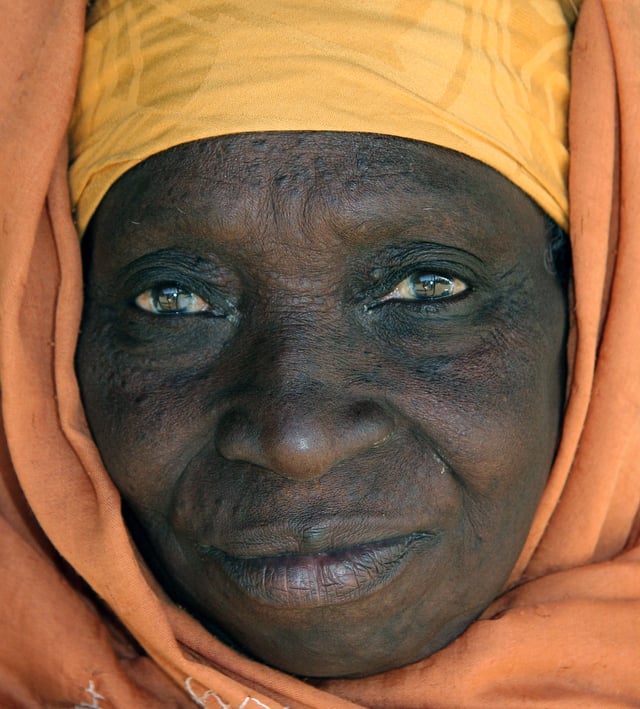
Muslim woman wearing a head dress (Hijab)
In Western cultures, the ideal of feminine appearance has traditionally included long, flowing hair, clear skin, a narrow waist, and little or no body hair or facial hair.[4][43]*The%20Last%20Taboo%3A%20W]]*m hair is not considered unfeminine.[45]*The%20Language%20of%20Magazin]]*The%20Language%20of%20Magazin]]*The%20Language%20of%20Magazin]]*The%20Language%20of%20Magazin]]*The%20Language%20of%20Magazin]]*oday, the color pink is strongly associated with femininity, whereas in the early 1900s pink was associated with boys and blue with girls.
In history
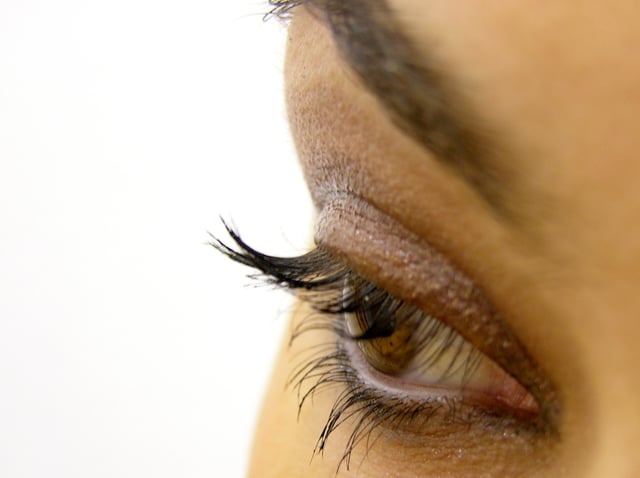
In some cultures, cosmetics are associated with femininity
In Ancient Egypt, sheath and beaded net dresses were considered female clothing, while wraparound dresses, perfumes, cosmetics, and elaborate jewelry were worn by both men and women. In Ancient Persia, clothing was generally unisex, though women wore veils and headscarves. Women in Ancient Greece wore himations; and in Ancient Rome women wore the palla, a rectangular mantle, and the maphorion.[53]
The typical feminine outfit of aristocratic women of the Renaissance was an undershirt with a gown and a high-waisted overgown, and a plucked forehead and beehive or turban-style hairdo.[53]
Body alteration
Body alteration is the deliberate altering of the human body for aesthetic or non-medical purpose.[54] One such purpose has been to induce perceived feminine characteristics in women.
Ideal feminine
What is considered as the ideal feminine is defined by each individual culture based on what that culture considers valuable, and is often the subject of heated debate.
Scholarly views

And we too, shall be mothers, because.......! by Jean-Jacques Lequeu, 1794
To understand the term "ideal feminine", we need to understand what femininity is.
“It embodies a constellation of meanings, it generally refers to the attributes, behaviors, interests, mannerisms, appearances, roles, and expectations that we have come to associate with being female during the socialization processes.
Gender role socialization relies on modeling and reinforcement – girls and women learn and internalize socially expected and acceptable feminine traits and behaviors and are rewarded for gender-appropriate behavior.”
[61] The Psychology of Women Quarterly also mentions that there are numerous psychological problems that are related to femininity among women and adolescent girls.
The social construct of femininity has adverse effects on women. What is lacking in current research of femininity is "a tool that allows for understanding women's subjective femininity experiences and assessing their relationships to women's psychological health."[61] What was later developed was the Subjective Femininity Stress Scale (SFSS), a scale that measures women's experiences of being female and to rate the levels of stress they may feel associated with their feminine experiences. We also know that "feminine norms from the dominant culture are insidiously powerful and pervasive and are likely to influence every woman living in American society [...] empirical evidence suggests that current studies on femininity (i.e. traits, role norms, gender role stress) may not fully capture the experiences of women from diverse backgrounds."[61]
The ideal feminine has been debated for centuries.
Virginia Woolf writes, "Women have served all these centuries as looking-glasses possessing the magic and delicious power of reflecting the figure of man at twice its natural size."[62] Woolf describes her as the Angel of the House. "She was intensely sympathetic. She was immensely charming. She was utterly unselfish. She excelled in the difficult arts of family life. She sacrificed herself daily. If there was chicken, she took the leg; if there was a draught she sat in it—in short she was so constituted that she never had a mind or a wish of her own, but preferred to sympathize always with the minds and wishes of others. Above all—I need not say it—she was pure. Her purity was supposed to be her chief beauty--her blushes, her great grace. In those days—the last of Queen Victoria—every house had its Angel."[63]
This relates to Simone de Beauvoir's point that women are the "other." Beauvoir points out that, "Man can think of himself without woman. She cannot think of herself without man. And she is simply what man decrees; thus called 'the sex', by which is meant that [...] she is sex – absolute sex, no less. She is defined and differentiated with reference to man and not he with reference to her; she is the incidental, the inessential as opposed to the essential. He is the Subject, he is the Absolute – she is the Other."[64] Beauvoir says that women are the "Second Sex" because they are secondary to men. Her coining of the "eternal feminine" solidifies this idea of ideal femininity. She was stating that a woman's femininity determines her worth and that a woman's value is based on the man's default. This "eternal feminine" was constructed because, as she points out, "They are women in virtue of their anatomy and physiology. Throughout history they have always been subordinated to men, and hence their dependency is not the result of a historical event or a social change – it was not something that occurred."[64] In order to understand the ideal feminine, one must understand the social constructs that made the ideal feminine.
Betty Friedan, who wrote The Feminine Mystique, also weighs in on the subject of the ideal feminine. She notes that, "The feminine mystique permits, even encourages, women to ignore the question of their identity. The mystique says they can answer the question 'Who am I?' by saying 'Tom's wife... Mary's mother.' – an American woman no longer has a private image to tell her who she is, or can be, or wants to be,"[65] and that women are not considered female if they do not abide by these societal norms and mores. Friedan thinks that "the core of the problem for women today is not sexual but a problem of identity – a stunting or evasion of growth that is perpetuated by the feminine mystique."[65] At the time this book was written, women were constantly shown their roles were that of the homemaker and the nurturer – if they wanted to be considered feminine, they would prescribe to these roles.
If ideal femininity is a woman who accepts and encourages femininity in all its forms, the opposite of the ideal feminine would be a lesbian.
They may shed the feminine identity in order to build their own identity and fight the "feminine mystique".
Monique Wittig writes, "lesbian society destroys the artificial (social) fact constituting women as a 'natural group.' A lesbian society pragmatically reveals that the division from men of which women have been the object is a political one and shows that we have been ideologically rebuilt into a 'natural group.' In the case of women, ideology goes far since our bodies as well as our minds are the product of this manipulation." She goes on to say, "as individuals as well we question 'woman,' which for us, as for Simone de Beauvoir, is only a myth." Wittig believes that women must, as the lesbians are doing, reject the definition of "'woman', which is imposed on them."[66]
Popular culture
In 1876, Horatio Alger, Jr. proclaimed women of Cape Cod as the ideal feminine beauty,[67] specifically, because they were blond, tan, physically fit and educated.
In 1959, the Barbie fashion doll was introduced as a feminine ideal of modern aesthetic beauty[68] by Mattel, in the United States. While there are those who hold Barbie to be the feminine ideal, Barbie's anatomical proportions are exaggerated and do not, for example, meet the aesthetic proportions that men in Western cultures find most attractive.[69][70][71] This icon of femininity,[72] in the views of some, attracts a wide international audience of women and men.[73] She has been used as a teaching tool for femininity.[74] One of the most common criticisms of Barbie is that she promotes an unrealistic and unattainable idea of feminine beauty and fits the weight criteria for anorexia.[75]
In China, female consumers rejected[76] Barbie's ideal of feminine beauty and its image for women as extraneously sexy.[77] In Iran, the feminine ideals and independent lifestyle represented by Barbie are considered a threat to Iranian values, "more harmful than an American missile."[78] In Saudi Arabia, Barbie was banned for the same reason, by the religious police as a moral threat to Islam.[79]
In 1975, American film critic, academic, and screenwriter Marjorie Rosen wrote in her book Popcorn Venus: Women, Movies, & the American Dream that the film industry presents a distorted image of femininity that reflects prevailing societal values. In 1987 American film critic Molly Haskell wrote that film not only reflects but reinforces society's accepted gender role definitions, saying "film is a rich field for the mining of female stereotypes... If we see stereotypes in film, it's because stereotypes existed in society."[22]
In post-match interviews, female tennis players have been found to resist media narratives that either give emphasis to stereotypical notions of gendered identities, such as femininity, or detract from their status as efficient professionals.[81]
Traditional roles

Teacher in a classroom in Madagascar (c. 2008). Teaching is often considered a feminine occupation.
Gender stereotypes influence traditional feminine occupations, resulting in microaggression toward women who break traditional gender roles.[82] These stereotypes include that women have a caring nature, have skill at household-related work, have greater manual dexterity than men, are more honest than men, and have a more attractive physical appearance. Occupational roles associated with these stereotypes include: midwife, teacher, accountant, data entry clerk, cashier, salesperson, receptionist, housekeeper, cook, maid, social worker, and nurse.[83] Occupational segregation maintains gender inequality[84] and gender pay gap.[85] Certain medical specializations, such as surgery and emergency medicine, are dominated by a masculine culture[86] and have a higher salary.[87][88]
Leadership is associated with masculinity in Western culture and women are perceived less favorably as potential leaders.[89] However, some people have argued that the "feminine"-style leadership, which is associated with leadership that focuses on help and cooperation, is advantageous over "masculine" leadership, which is associated with focusing on tasks and control.[90]*Women%20and%20Leadership%3A%20A%20Contextual]]*Women%20and%20Leadership%3A%20A%20Contextual]]*Women%20and%20Leadership%3A%20A%20Contextual]]*Women%20and%20Leadership%3A%20A%20Contextual]]*Women%20and%20Leadership%3A%20A%20Contextual]]*emale leaders are more often described by Western media using characteristics associated with femininity, such as emotion.
Explanations for occupational imbalance
It has been argued that primary sex characteristics of men and women, such as the ability to bear children, caused a historical sexual division of labor and gender stereotypes evolved culturally to perpetuate this division.[7]
The practice of bearing children tends to interrupt the continuity of employment.
According to human capital theory, this retracts from the female investment in higher education and employment training. Richard Anker of the International Labour Office argues human capital theory does not explain the sexual division of labor because many occupations tied to feminine roles, such as administrative assistance, require more knowledge, experience, and continuity of employment than unskilled masculinized occupations, such as truck driving. Anker argues the feminization of certain occupations limits employment options for women.[83]
Role congruity theory
Role congruity theory proposes that people tend to view deviations from expected gender roles negatively. It supports the empirical evidence that gender discrimination exists in areas traditionally associated with one gender or the other. It is sometimes used to explain why people have a tendency to evaluate behavior that fulfills the prescriptions of a leader role less favorably when it is enacted by a woman.[91][92][93][94][95]
Religion and politics
Asian religions
Shamanism may have originated as early as the paleolithic period, predating all organized religions.[97][98] Archeological finds have suggested that the earliest known shamans were female,[99] and contemporary shamanic roles such as the Korean mudang continue to be filled primarily by women.[100][101]
In Hindu traditions, Devi is the female aspect of the divine. Shakti is the divine feminine creative power, the sacred force that moves through the entire universe[102] and the agent of change. She is the female counterpart without whom the male aspect, which represents consciousness or discrimination, remains impotent and void. As the female manifestation of the supreme lord, she is also called Prakriti, the basic nature of intelligence by which the Universe exists and functions. In Hinduism, the universal creative force Yoni is feminine, with inspiration being the life force of creation.
In Taoism, the concept of yin represents the primary force of the female half of yin and yang. The yin is also present, to a smaller proportion, in the male half. The yin can be characterized as slow, soft, yielding, diffuse, cold, wet, and passive.[103]
In Buddhism, women have been recognized and characterized vary in terms of their ability to achieve the truth of the Buddhahood (enlightenment) based on the Buddhist schools. For example, sutras in Early Buddhism depicted "A woman of a top master of Wisdom" as a woman who achieved enlightenment. But later Hinayana preached such great persons,including the ten great disciples of Buddha, are limited to men, with women as an inferior being, and as the whole, denied the possibility of women's enlightenment in this lifetime (i.e. woman should reborn as men in future lifetime). Then Mahayara again stated woman's enlightenment as a result of the present time practices.[104]
Judeo-Christian theology
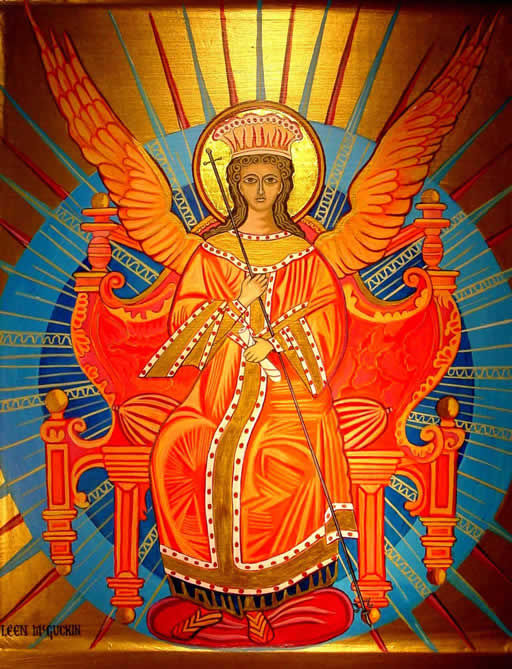
Holy Wisdom: Hagia Sophia
Although the Judeo-Christian God is typically described in masculine terms—such as father, king, warrior—many theologians argue that this is not meant to indicate the gender of God.[105] According to the Catechism of the Catholic Church, God "is neither man nor woman: he is God."[106] Several recent writers, such as Sally McFague, have explored the idea of "God as mother", examining the feminine qualities attributed to God. For example, in the Book of Isaiah, God is compared to a mother comforting her child, while in the Book of Deuteronomy, God is said to have given birth to Israel.[105]
The Book of Genesis describes divine creation of the world out of nothing or ex nihilo. In Wisdom literature and in the wisdom tradition, wisdom is described as feminine. In many books of the Old Testament, including Wisdom and Sirach, wisdom is personified and called "she." According to David Winston, because wisdom is God's "creative agent," she must be intimately identified with God.[107]
The Wisdom of God is feminine in Hebrew: Chokhmah, in Arabic: Hikmah, in Greek: Sophia, and in Latin: Sapientia. In Hebrew, both Shekhinah (the Holy Spirit and divine presence of God) and Ruach HaKodesh (divine inspiration) are feminine.
In the Jewish Kabbalah, Chokhmah (wisdom and intuition) is the force in the creative process that God used to create the heavens and the earth. Binah (understanding and perception) is the great mother, the feminine receiver of energy and giver of form. Binah receives the intuitive insight from Chokhmah and dwells on it in the same way that a mother receives the seed from the father, and keeps it within her until it's time to give birth. The intuition, once received and contemplated with perception, leads to the Creation of the Universe.[108]
Communism
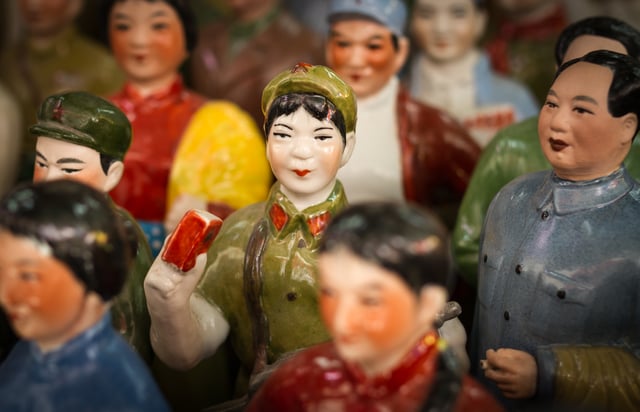
Porcelain statue of a woman in Communist China - Cat Street Market, Hong Kong
Communist revolutionaries initially depicted idealized womanhood as muscular, plainly dressed and strong,[109] with good female communists shown as undertaking hard manual labour, using guns, and eschewing self-adornment.[110] Contemporary Western journalists portrayed communist states as the enemy of traditional femininity, describing women in communist countries as "mannish" perversions.[111]Amazons%20of%20the%20Huk%20Rebel]] revolutionary China ut makeup, hair waves or nail polish" and wrote that "Glamour was communism's earliest victim in China. You can stroll the cheerless streets of Peking all day, without seeing a skirt or a sign of lipstick; without thrilling to the faintest breath of perfume; without hearing the click of high heels, or catching the glint of legs sheathed in nylon."[112][114] In communist Poland, changing from high heels to worker's boots symbolized women's shift from the bourgeois to socialism."[115]
Later, the initial state portrayals of idealized femininity as strong and hard-working began to also include more traditional notions such as gentleness, caring and nurturing behaviour, softness, modesty and moral virtue,[109][116]*Russia%20]]*Russia%20]]*Russia%20]]*Russia%20]]*equiring good Communist women to become "superheroes who excelled in all spheres", including working at jobs not traditionally regarded as feminine in nature.
Communist ideology explicitly rejected some aspects of traditional femininity that it viewed as bourgeois and consumerist, such as helplessness, idleness and self-adornment.
In Communist countries, some women resented not having access to cosmetics and fashionable clothes.
In her 1993 book of essays How We Survived Communism & Even Laughed, Croatian journalist and novelist Slavenka Drakulic wrote about "a complaint I heard repeatedly from women in Warsaw, Budapest, Prague, Sofia, East Berlin: 'Look at us – we don't even look like women. There are no deodorants, perfumes, sometimes even no soap or toothpaste. There is no fine underwear, no pantyhose, no nice lingerie"[117] and "Sometimes I think the real Iron Curtain is made of silky, shiny images of pretty women dressed in wonderful clothes, of pictures from women's magazines... The images that cross the borders in magazines, movies or videos are therefore more dangerous than any secret weapon, because they make one desire that 'otherness' badly enough to risk one's life trying to escape."[117]
As Communist countries such as Romania and the Soviet Union began to liberalize, their official media began representing women in more conventionally feminine ways compared with the "rotund farm workers and plain-Jane factory hand" depictions they had previously been publishing. As perfumes, cosmetics, fashionable clothing, and footwear became available to ordinary women in the Soviet Union, East Germany, Poland, Yugoslavia and Hungary, they began to be presented not as bourgeois frivolities but as signs of socialist modernity.[118] In China, with the economic liberation started by Deng Xiaoping in the 1980s, the state stopped discouraging women from expressing conventional femininity, and gender stereotypes and commercialized sexualization of women which had been suppressed under Communist ideology began to rise.[119]
In men
In Western culture, effeminate men are often associated with homosexuality,[120][121] although femininity is not necessarily related to a man's sexuality.[122] Because men are pressured to be masculine and heterosexual, feminine men are stigmatized and assumed to be gay or queer because of how they perform their gender. This assumption limits the way one is allowed to express one's gender and sexuality.[123][124]*The%20Man%20Who%20Would%20Be%20Q]]*The%20Man%20Who%20Would%20Be%20Q]]*The%20Man%20Who%20Would%20Be%20Q]]*The%20Man%20Who%20Would%20Be%20Q]]The%20Man%20Who%20Would%20Be%20Q]]
Cross-dressing and drag are two public performances of femininity by men that have been popularly known and understood throughout many western cultures.
Men who wear clothing associated with femininity are often called cross-dressers.[126] A drag queen is a man who wears flamboyant women's clothing and behaves in an exaggeratedly feminine manner for entertainment purposes.
Feminist views
Feminist philosophers such as Judith Butler and Simone de Beauvoir[1] contend that femininity and masculinity are created through repeated performances of gender; these performances reproduce and define the traditional categories of sex and/or gender.[127]
Many second-wave feminists reject what they regard as constricting standards of female beauty, created for the subordination and objectifying of women and self-perpetuated by reproductive competition and women's own aesthetics.[128]
Others, such as lipstick feminists and some other third-wave feminists, argue that feminism shouldn't devalue feminine culture and identity, and that symbols of feminine identity such as make-up, suggestive clothing and having a sexual allure can be valid and empowering personal choices for both sexes.[129][130]
Julia Serano notes that masculine girls and women face much less social disapproval than feminine boys and men, which she attributes to sexism. Serano argues that women wanting to be like men is consistent with the idea that maleness is more valued in contemporary culture than femaleness, whereas men being willing to give up masculinity in favour of femininity directly threatens the notion of male superiority as well as the idea that men and women should be opposites. To support her thesis, Serano cites the far greater public scrutiny and disdain experienced by male-to-female cross-dressers compared with that faced by women who dress in masculine clothes, as well as research showing that parents are likelier to respond negatively to sons who like Barbie dolls and ballet or wear nail polish than they are to daughters exhibiting comparably masculine behaviours.[131]
Julia Serano's transfeminist critique
In her 2007 book Whipping Girl: A Transsexual Woman on Sexism and the Scapegoating of Femininity, American transsexual writer and biologist Julia Serano offers a transfeminist critique of femininity, notable especially for its call to empower femininity:[131][132]
In this book, I break with past attempts in feminism and queer theory to dismiss femininity by characterizing it as “artificial” or “performance.”
Instead, I argue that certain aspects of femininity (as well as masculinity) are natural and can both precede socialization and supersede biological sex.
For these reasons, I believe that it is negligent for feminists to only focus on those who are female-bodied, or for transgender activists to only talk about binary gender norms, as no form of gender equity can ever truly be achieved until we first work to empower all forms of femininity.
Serano notes that some behaviors, such as frequent smiling or avoiding eye contact with strangers, are considered feminine because they are practiced disproportionately by women, and likely have resulted from women's attempts to negotiate through a world which is sometimes hostile to them.[131]
Serano argues that because contemporary culture is sexist, it assigns negative connotations to, or trivializes, behaviours understood to be feminine such as gossiping, behaving emotionally or decorating.
It also recasts and reimagines femininity through a male heterosexual lens, for example interpreting women's empathy and altruism as husband-and-child-focused rather than globally focused, and interpreting women's interest in aesthetics as intended solely to entice or attract men.[131] She writes that femininity is frequently understood as perplexing and mysterious, and notes that words like spell-binding and enchanting are often used to describe feminine women, illustrating that men don't need to understand and appreciate women's experiences in the same way in which women must understand and appreciate theirs, and indeed that men are discouraged from doing so.[131]
See also
Feminine psychology
Feminization (sociology)
Masculinity
Gender role
Gender studies
Marianismo
Nature versus nurture
Sociology of gender
Transfeminine

